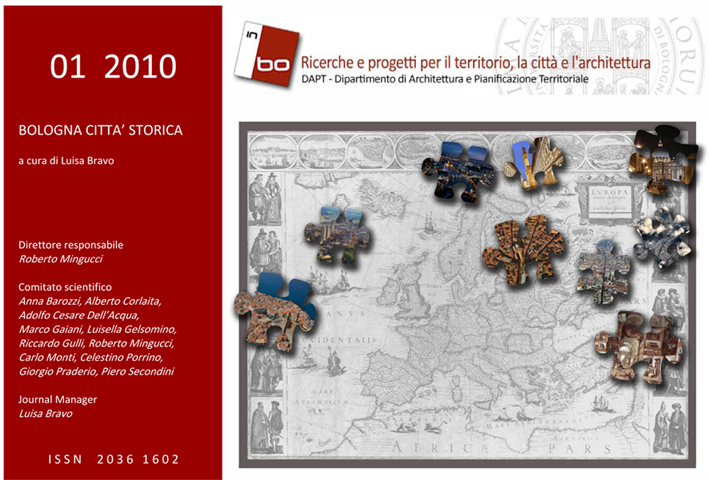Contemporary historic city: genius loci and genius saeculi
DOI:
https://doi.org/10.6092/issn.2036-1602/2162Keywords:
genius loci, genius saeculi, contemporary historic city,Abstract
Recent literature shows the limits of modern town-planning theory in front of the complexity of a new world which is the result of political, economic and social transformation. The genius loci in the historical dimension of the city is what survives to the ever changing functional structures and confers an indelible character to the city and the urban landscape, through different urban phenomena but part of a single and recognizable experience. The contemporary dimension of historical city, namely genius saeculi, requires a continuous updating of the collective themes, of public spaces and contents that are assigned to the historical forms from people who lives and inhabit those places, and the inclusion of new meanings, new values, new forms of social life. Hence this is the challenge for the new Millennium: conciliating the spirit of place, genius loci, with the spirit of time, genius saeculi, retrieving history values through their preservation and combining them in the present time through a sustainable model.References
Geddes, P. (1915) “Cities in evolution”, Williams and Borgate, London
Giovannoni, G. (1931) “Vecchie città ed edilizia nuova”, Utet, Torino
Park, R. E., Burgess, E. W. and McKenzie, R. D. (1938) “The city”, The University of Chicago Press, Chicago
Mumford, L. (1938) “The culture of cities”, Hartcourt Brace & Co., New York
Wirth, L. (1938) “Urbanism as a way of life”, in American Journal of Sociology, 44
Giedion, S. (1941) “Space, time and architecture”, Harvard University Press, Cambridge, Massachussets
Lynch, K. (1960) “The image of the city”, MIT Press, Cambridge, Massachussets
Cullen, G (1961) “Townscape”, The Architectural Press, London
Jacobs, J. (1961) “The death and life of great american cities”, Vintage Books, New York
Astengo, G. (1966) “Urbanistica”, Enciclopedia Universale dell’arte, XIV, Istituto per la collaborazione culturale, Sansoni, Firenze
Rossi, A. (1966) “L'architettura della città”, Marsilio, Padova
Durkheim, E. (1970) “La Science sociale et l’Action“, Presses Universitaires de France, Paris
Calvino, I. (1972) “Le città invisibili”, Einaudi, Torino
Friedman, Y (1974) “Utopies Réalisables”, Editions de l’éclat, Paris
Lynch, K. (1981) “A theory of good city form”, MIT Press, Cambridge, Massachussets
Alexander, C (1987) “A new theory of urban design”, Oxford University Press, Oxford
Gehl, J. (1987) “Life Between Buildings. Using Public Space”, Van Nostrand Reinhold, New York (first edition)
Sassen, S. (1991) “The Global City”, Princeton University Press, Princeton
Augè, M. (1992) “Non-lieux”, Edition du Seuil, Paris
Martinotti, G. (1993) “Metropoli. La nuova morfologia sociale della città”, Il Mulino, Bologna
Sen, A. K. (1993) “Capability and wellbeing”, Nussbaum, N. and Sen, A. K. “The quality of life” Clarendon press, Oxford
Le Galès, P. (1995), “European Cities”, Oxford University Press, Oxford
Bauman, Z. (1997) “Liquid Modernity”, Polity Press, Cambridge
Amin, A. and Thrift N. (2001) “Cities. Reimagining the Urban”, Polity Press, Cambridge
Koolhaas, R. (2001) “Junkspace”, Project on the City 2/Harvard Design School, “Guide to shopping”, Taschen, Köln
Belli, A. (2004) “Come valore d’ombra. Urbanistica oltre la ragione”, Franco Angeli, Milano
Basilico, G. (2006) “Scattered cities”, Baldini e Castoldi, Milano
Indovina, F. (2006), (edited by) “Nuovo lessico urbano”, Franco Angeli, Milano
Mela, A. (2006) “Sociologia delle città”, Carocci, Roma
Downloads
How to Cite
Issue
Section
License
Copyright (c) 2010 Luisa Bravo
Copyrights and publishing rights of all the texts on this journal belong to the respective authors without restrictions.
This journal is licensed under a Creative Commons Attribution-NonCommercial 4.0 International License (full legal code).
See also our Open Access Policy.
Metadata
All the metadata of the published material is released in the public domain and may be used by anyone free of charge. This includes references.
Metadata — including references — may be re-used in any medium without prior permission for both not-for-profit and for-profit purposes. We kindly ask users to provide a link to the original metadata record.







